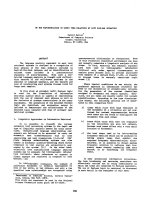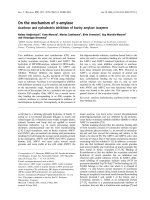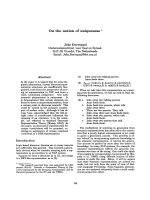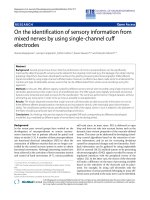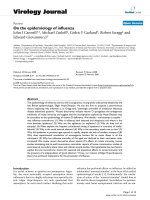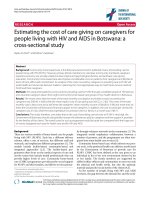Báo cáo hóa học: " ON THE STUDY OF A CLASS OF VARIATIONAL INEQUALITIES VIA LERAY-SCHAUDER DEGREE" pot
Bạn đang xem bản rút gọn của tài liệu. Xem và tải ngay bản đầy đủ của tài liệu tại đây (521.19 KB, 11 trang )
ON THE STUDY OF A CLASS OF VARIATIONAL
INEQUALITIES VIA LERAY-SCHAUDER DEGREE
D. GOELEVEN, D. MOTREANU, AND V. V. MOTREANU
Received 12 July 2004
We present existence results for general variational inequalities without monotonicity
or coercivity assumptions. It relies on a Leray-Schauder degree approach and provides
additional information about the location of solutions.
1. Introduction
The study of variational inequalities is very important from a theoretic point of view in
mathematics as well as for its various and significant applications in different fields, for
instance, in what is called nonsmooth mechanics [1, 3, 10]. Comprehensive treatment of
different problems related to variational inequalities and their applications can be found
in the monographs [2, 5, 6, 7, 8]. A basic assumption in the results studying the vari-
ational inequalities on a Hilbert space is the monotonicity condition, in particular, the
ellipticity (or coercivity) hypothesis on the (possibly nonlinear) operator entering the
problem. The interest to relax this condition, by imposing other type of assumptions, is
a real challenge in the recent developments. The present paper is devoted to this topic,
where in place of monotonicity there are supposed suitable assumptions allowing the
application of topological degree arguments. Our approa ch permits to encompass the
solvability of cases that were not covered by the previous known results.
We describe the functional setting of the paper. Let H be a real Hilbert space endowed
with the scalar product
·,· and the associated norm ·.
Consider the following general assumptions on the data in our variational inequality
formulation (see problem (1.3)):
(H1) Φ : H
→ H is a compact mapping, that is, Φ is continuous and maps the bounded
sets onto re latively compact sets;
(H2) ϕ : H → R is a convex and continuous function which is bounded from above on
the bounded subsets of H.
Since a convex and lower semicontinuous function on H is bounded from below by an
affine function, it is bounded from below on the bounded subsets of H. Hypothesis (H2)
ensures thus that the function ϕ is bounded on the bounded subsets of H.Westressthat
Copyright © 2004 Hindawi Publishing Corporation
Fixed Point Theory and Applications 2004:4 (2004) 261–271
2000 Mathematics Subject Classification: 49J40, 35K85, 47H11
URL: />262 Variational inequalities via Leray-Schauder degree
the property of the function ϕ : H → R to be bounded from above on the bounded subsets
of H as assumed in (H2) is not satisfied, in general, by a convex and continuous function
ϕ on H. We provide an example in this direction based on private communication with
J. Saint Raymond (2004).
Example 1.1. Consider the Hilbert space
2
and the function f :
2
→ R defined by
f (x) = sup
n≥0
2n
x
n
− n
∀x ∈
2
, (1.1)
where x
n
are the components of x. The function f is convex, continuous, and not bound-
ed on the bounded sets. Indeed, f is defined on
2
because for any x ∈
2
the set
n :2n
x
n
− n ≥ 0
=
n :
x
n
≥
1
2
(1.2)
is finite. The function f is convex, since it is the upper hull of the convex functions f
n
on
2
given by f
n
(x) = 2n|x
n
|−n. We note that f is zero on the ball centered at 0 and
of radius 1/2 because 0 = f
0
(x) ≤ f (x)and2|x
n
|≤1ifx < 1/2. Being bounded on a
nonempty open set, the function f is continuous. Finally, it is seen that f (e
n
) = n,where
e
n
is the nth vector of the canonical basis of
2
. It turns out that the function f is not
bounded from above on the unit sphere in
2
.
Given Φ : H → H and ϕ : H → R, we formulate now our variational inequality prob-
lem: find
¯
x ∈ H such that
¯
x
− Φ(
¯
x), v −
¯
x
+ ϕ(v) − ϕ(
¯
x) ≥ 0 ∀v ∈ H. (1.3)
Our approach in studying the variational inequality (1.3) relies on the Leray-Schauder
degree theory (see [4, 9]). Assumption (H1) is mainly imposed to fi t the setting of the
Leray-Schauder degree theory.
Several approaches using degree theory have been recently developed so as to study
problems like the one given in (1.3), even for general classes of proper, convex, and lower
semicontinuous functions ϕ (see [6, 11]), but here we give a more qualitative insight on
the topic. Specifically, assumption (H2) allows us to develop a new and powerful contin-
uation result (see Proposition 2.3). Using this continuation result for problem (1.3), we
prove several new results guaranteeing the existence of solutions (see Section 3). Some
location information on the solution set of problem (1.3) is also available through our
results, for example, criteria to have nontrivial solutions. Here the hypotheses (H1) and
(H2) play an essential role. Special attention is paid to the situation where the Hilbert
space H is finite dimensional. It is worth noting that if H is finite dimensional, then
every continuous mapping Φ : H
→ H satisfies assumption (H1), and every continuous
and convex function ϕ : H → R fulfills assumption (H2). This enables us to have great
flexibility in applying our results in the case H =
R
N
.
Our main argument lies in the use of a nonlinear operator P
ϕ
: H → H whichisrelated
to the function ϕ in problem (1.3) and hypothesis (H2).
The rest of the paper is organized as follows. Section 2 contains some preliminary
results to set up our topological degree framework. Section 3 is devoted to our existence
results for the variational inequality (1.3).
D. Goeleven et al. 263
2. Preliminary results
This section concerns an auxiliary variational inequality on a real Hilbert space H whose
solution will be the main tool in solving problem (1.3). In the sequel we denote by id
H
the
identity mapping on H. For later use, for any r>0, we denote B
r
:={x ∈ H : x <r},
¯
B
r
:={x ∈ H : x≤r},and∂B
r
:={x ∈ H : x=r}.
Let ϕ : H → R be a convex and continuous function. The notation ∂ϕ stands for the
subdifferential of ϕ in the sense of convex analysis, that is, the nonempty set
∂ϕ(x) =
w ∈ H : ϕ(v) − ϕ(x) ≥w,v − x∀v ∈ H
. (2.1)
The subdifferential ∂ϕ is defined everywhere on H because the function ϕ is convex and
continuous on H.
For a fixed element y ∈ H, we state the variational inequality problem: find x ∈ H
such that
x − y,v − x + ϕ(v) − ϕ(x) ≥ 0 ∀v ∈ H. (2.2)
It is well known that problem (2.2) has a unique solution x ∈ H (see, e.g., [2, 4, 8]).
Therefore the well-defined (nonlinear) operator P
ϕ
: H → H given by
P
ϕ
(y) = x ∀y ∈ H, (2.3)
where x ∈ H, is the solution to (2.2). We note that P
0
y = y for all y ∈ H.
First we discuss the continuity properties of the nonlinear operator P
ϕ
described in
(2.2)and(2.3).
Proposition 2.1. Let ϕ : H
→ R be a convex and continuous function. Then the operator
P
ϕ
is continuous.
Proof. Let {y
n
}⊂H be a sequence such that y
n
→ y
∗
as n → +∞.WeclaimthatP
ϕ
(y
n
) →
P
ϕ
(y
∗
)inH as n → +∞. Indeed, denoting x
n
:= P
ϕ
(y
n
)andx
∗
:= P
ϕ
(y
∗
), we have from
(2.3)and(2.2)that
x
n
− y
n
,v − x
n
+ ϕ(v) − ϕ
x
n
≥ 0 ∀v ∈ H, (2.4)
x
∗
− y
∗
,v − x
∗
+ ϕ(v) − ϕ
x
∗
≥ 0 ∀v ∈ H. (2.5)
If we set v = x
∗
in (2.4)andv = x
n
in (2.5), we obtain
x
n
− y
n
,x
n
− x
∗
− ϕ
x
∗
+ ϕ
x
n
≤ 0,
−
x
∗
− y
∗
,x
n
− x
∗
− ϕ(x
n
)+ϕ
x
∗
≤ 0.
(2.6)
We derive
x
n
− x
∗
2
≤
x
n
− x
∗
y
n
− y
∗
. (2.7)
It follows that x
n
→ x
∗
in H as n → +∞, and the conclusion is achieved.
264 Variational inequalities via Leray-Schauder degree
Proposition 2.2. Let G :[0,T] × H → H beacontinuousfunctionon[0,T] × H,witha
number T>0,andletϕ : H → R satisfy hypothesis (H2). Then the mapping
(λ, y) ∈ [0,T] × H −→ P
λϕ
G(λ, y)
∈ H (2.8)
is continuous on [0,T]
× H,whereP
λϕ
is the nonlinear operator introduced by (2.2)and
(2.3).
Proof. We check the continuity at an arbitrary point (λ
∗
, y
∗
) ∈ [0,T] × H. Consider the
convergent sequences {y
n
}⊂H and {λ
n
}⊂[0,T]withy
n
→ y
∗
in H and λ
n
→ λ
∗
in
R as n → +∞. We have to show that P
λ
n
ϕ
(G(λ
n
, y
n
)) → P
λ
∗
ϕ
(G(λ
∗
, y
∗
)) in H as n → +∞.
Denote x
n
:= P
λ
n
ϕ
(G(λ
n
, y
n
)) and x
∗
:= P
λ
∗
ϕ
(G(λ
∗
, y
∗
)). By the definition of the mapping
P
λϕ
in (2.2)and(2.3)itisknownthat
x
n
− G
λ
n
, y
n
,v − x
n
+ λ
n
ϕ(v) − λ
n
ϕ
x
n
≥ 0 ∀v ∈ H, (2.9)
x
∗
− G
λ
∗
, y
∗
,v − x
∗
+ λ
∗
ϕ(v) − λ
∗
ϕ
x
∗
≥ 0 ∀v ∈ H. (2.10)
We first prove that the sequence {x
n
} is bounded. To this end, suppose, on the contrary,
that along a relabeled subsequence one has x
n
→+∞ as n → +∞.Settingv = 0in(2.9),
we obtain
−
x
n
− G
λ
n
, y
n
,x
n
+ λ
n
ϕ(0) − ϕ
x
n
≥
0. (2.11)
This leads to
1 ≤
G
λ
n
, y
n
x
n
+
λ
n
x
n
2
ϕ(0) − ϕ
x
n
. (2.12)
For n largeenough,wemayadmitthat1/x
n
∈(0,1]. Using the convexity of ϕ we obtain
ϕ
x
n
x
n
≤
1
x
n
ϕ
x
n
+
1 −
1
x
n
ϕ(0) (2.13)
or, equivalently,
ϕ(0)
− ϕ
x
n
x
n
≤ ϕ(0) − ϕ
x
n
x
n
. (2.14)
Combining with (2.12) implies
1
≤
G
λ
n
, y
n
x
n
+ λ
n
ϕ(0) − ϕ
x
n
/
x
n
x
n
. (2.15)
Since the function ϕ is convex and continuous on the whole s pace H, it turns out ϕ is
bounded from below on the bounded subsets of H. Consequently, in conjunction with
assumption (H2), one has that ϕ is bounded on the bounded subsets of H. This ensures
that
lim
n→+∞
ϕ
x
n
/
x
n
x
n
=
0. (2.16)
D. Goeleven et al. 265
Passing to the limit as n → +∞ in (2.15) and using the continuity of G, we arrive at con-
tradiction. Therefore the sequence {x
n
} is bounded in H.
Setting now v = x
∗
in (2.9)andv = x
n
in (2.10)allowstowrite
x
n
− G
λ
n
, y
n
,x
n
− x
∗
− λ
n
ϕ
x
∗
+ λ
n
ϕ
x
n
≤ 0,
−
x
∗
− G
λ
∗
, y
∗
,x
n
− x
∗
− λ
∗
ϕ
x
n
+ λ
∗
ϕ
x
∗
≤ 0.
(2.17)
It follows that
x
n
− x
∗
2
≤
G
λ
n
, y
n
− G
λ
∗
, y
∗
x
n
− x
∗
+
λ
n
− λ
∗
ϕ
x
∗
+
λ
∗
− λ
n
ϕ
x
n
.
(2.18)
The continuity of G gives G(λ
n
, y
n
) − G(λ
∗
, y
∗
)→0, while the boundedness of the
sequence {x
n
} combined with assumption (H2) guarante es that the sequence {ϕ(x
n
)}
is bounded. It is then clear t hat (2.18)yieldsx
n
→ x
∗
as n → +∞, which completes the
proof.
The following technical result is useful for the computations involving the Leray-
Schauder degree in the next section. We recall that, given a compact mapping Ψ :
¯
B
r
→ H
such that 0 /∈ (id
H
−Ψ)(∂B
r
), there exists the Leray-Schauder degree deg(id
H
−Ψ,B
r
,0) of
id
H
−Ψ in B
r
with respect to 0 (see, e.g., [4, 9]).
Proposition 2.3. Assume that conditions (H1) and (H2) on the mappings Φ : H → H and
ϕ : H → R, respectively, are fulfilled. If there exists a compact mapping χ : H → H and a
number r>0 such that
x − Φ (x),χ(x) − x
+ ϕ
χ(x)
− ϕ(x) < 0 ∀x ∈ H, x=r, (2.19)
then the follow ing equality holds:
deg
id
H
−P
ϕ
Φ,B
r
,0
=
deg
id
H
−χ,B
r
,0
. (2.20)
Proof. Notice that the mapping P
ϕ
Φ is compact being the composition of the continuous
mapping P
ϕ
(cf. Proposition 2.1) and the compact one Φ (cf. (H1)). So the mapping
id
H
−P
ϕ
Φ is of the form required in the definition of the Leray-Schauder degree (see
[4, 9]). Let h : [0,1] ×
¯
B
r
→ H be the mapping defined by
h(λ, y) = y − P
λϕ
λΦ(y)+(1− λ)χ(y)
∀(λ, y) ∈ [0,1] ×
¯
B
r
. (2.21)
Applying Proposition 2.2 with G : [0,1] × H → H given by G(λ, y) = λΦ(y)+(1− λ)χ(y),
for all (λ, y) ∈ [0,1] × H, we infer that h is a continuous mapping. Moreover, since Φ and
χ are compact, for each λ ∈ [0,1], the mapping y → P
λϕ
(λΦ(y)+(1− λ)χ(y)) is compact
too.
266 Variational inequalities via Leray-Schauder degree
We claim t h at
h(λ,x) = 0 ∀λ ∈ [0,1], ∀x ∈ ∂B
r
. (2.22)
Arguing by contradiction, suppose that there exist x ∈ H,withx=r,andλ ∈ [0, 1]
such that h(λ,x) = 0. This reads as
x = P
λϕ
λΦ(x)+(1− λ)χ(x)
. (2.23)
We first remark that
λ>0. (2.24)
If not, we have λ = 0 and equality (2.23)reducestox = P
0
(χ(x)) = χ(x), which contradicts
assumption (2.19). Thus (2.24)holdstrue.
On the other hand, (2.23) expresses that
x − λΦ(x) − (1 − λ)χ(x),v − x
+ λϕ(v) − λϕ(x) ≥ 0 ∀v ∈ H. (2.25)
For v = χ(x), it is seen that
λ
x − Φ (x),χ(x) − x
+ ϕ
χ(x)
− ϕ(x)
≥ (1 − λ)
χ(x) − x
2
≥ 0. (2.26)
In view of (2.24)wederive
x − Φ(x),χ(x) − x
+ ϕ
χ(x)
− ϕ(x) ≥ 0. (2.27)
This contradicts assumption (2.19). Property (2.22) is established.
On the basis of (2.22), the homotopy invariance property of the Leray-Schauder degree
implies
deg
id
H
−P
ϕ
Φ,B
r
,0
=
deg
h(1,·),B
r
,0
=
deg
h(0,·),B
r
,0
=
deg
id
H
−P
0
χ,B
r
,0
=
deg
id
H
−χ,B
r
,0
.
(2.28)
The proof is thus complete.
3. Existence theorems
Our first main existence result in studying problem (1.3)isthefollowing.
Theorem 3.1. Assume that (H1), (H2) hold and that
(H3) there exists r>0 such that
x − Φ (x),x
+ ϕ(x) − ϕ(0) > 0 ∀x ∈ H, x=r. (3.1)
Then problem (1.3) has at least a solution in B
r
, that is, there exists
¯
x ∈ B
r
such that
¯
x − Φ (
¯
x), v −
¯
x
+ ϕ(v) − ϕ(
¯
x) ≥ 0 ∀v ∈ H. (3.2)
D. Goeleven et al. 267
Proof. Assumption (H3) entails that relation (2.19) is fulfilled for χ = 0. Consequently,
Proposition 2.3 can be applied with χ = 0. Thus we have
deg
id
H
−P
ϕ
Φ,B
r
,0
= deg
id
H
,B
r
,0
= 1 = 0. (3.3)
A basic property of Leray-Schauder degree ensures that there exists
¯
x ∈ B
r
verifying
¯
x =
P
ϕ
(Φ(
¯
x)). Taking into account (2.2), it follows that
¯
x solves problem (1.3).
Theorem 3.1 yields a sufficient condition for the existence of nontrivial solutions in
solving problem (1.3).
Corollary 3.2. Assume that the hypothes es of Theorem 3.1 hold and, in addition, there
exists a point v
0
∈ H \{0} such that
Φ(0),v
0
>ϕ
v
0
− ϕ(0). (3.4)
Then problem (1.3) has at least a nontrivial solution in B
r
.
Proof. Applying Theorem 3.1,wefind
¯
x ∈ B
r
verifying (1.3). In view of (3.4), one obtains
that
¯
x = 0.
The next result provides verifiable conditions under which Theorem 3.1 can be ap-
plied.
Corollary 3.3. Suppose that conditions (H1) and (H2) are verified as well as 0 ∈ ∂ϕ(0)
and that
(H3
) there exists r>0 such that
x − Φ(x),x
> 0 ∀x ∈ H, x=r. (3.5)
Then problem (1.3) has at least a solution in B
r
.
Proof. TheresultfollowsfromTheorem 3.1 observing that assumptions (H3
)and0∈
∂ϕ(0) imply (H3).
A second main existence result in solving problem (1.3)isnowgiven.
Theorem 3.4. Assume that (H1), (H2) hold and that
(H3
) there exists r>0 such that
ϕ
Φ(x)
− ϕ(x) <
Φ(x) − x
2
∀x ∈ H, x=r,
deg
id
H
−Φ,B
r
,0
= 0.
(3.6)
Then problem (1.3) has at least a solution in B
r
.
268 Variational inequalities via Leray-Schauder degree
Proof. We apply Proposition 2.3 with χ = Φ. This is possible because relation (2.19)is
fulfilled for χ = Φ. It turns out from Proposition 2.3 that
deg
id
H
−P
ϕ
Φ,B
r
,0
=
deg
id
H
−Φ,B
r
,0
. (3.7)
According to assumption (H3
), we infer that
deg
id
H
−P
ϕ
Φ,B
r
,0
= 0. (3.8)
It follows that there exists
¯
x ∈ B
r
such that
¯
x = P
ϕ
(Φ(
¯
x)). This allows us to conclude.
Theorem 3.4 gives r ise to the following result.
Corollary 3.5. Assume the hypotheses of Theorem 3.4 hold and that there exists a point
v
0
∈ H \{0} satisfying (3.4). Then problem (1.3) admits at least a nontrivial solution in B
r
.
Proof. The existence of a solution follows from Theorem 3.4. The obtained solution
¯
x ∈
B
r
of problem (1.3)isnontrivialbecause(3.4) prevents having
¯
x = 0.
We have the following sig nificant case of Theorem 3.4.
Corollary 3.6. Suppose that (H1) holds and that
(H2
) ϕ : H → R is convex and Lipschitz continuous with Lipschitz constant K>0,thatis,
ϕ(x) − ϕ(y)
≤ Kx − y∀x, y ∈ H; (3.9)
(H3
) there exists r>0 such that
x − Φ (x)
>K ∀x ∈ H with x=r,
deg
id
H
−Φ,B
r
,0
= 0.
(3.10)
Then problem (1.3) has at least a solution in B
r
.
Proof. It is worth noting that because a Lipschitz continuous function is bounded on
bounded sets, assumption (H2
) assures that (H2) is satisfied. We see again from (H2
)
that
ϕ
Φ(x)
− ϕ(x) −
Φ(x) − x
2
≤ K
x − Φ (x)
−
x − Φ(x)
2
=
x − Φ (x)
K −
x − Φ (x)
.
(3.11)
Thus, due to (H3
), we have
ϕ
Φ(x)
− ϕ(x) −
Φ(x) − x
2
< 0 ∀x ∈ H, x=r. (3.12)
Since (H3
) holds, the conclusion follows from Theorem 3.4.
WepointoutarelevantspecialcaseofCorollary 3.6.
D. Goeleven et al. 269
Theorem 3.7. Assume that (H2
) holds and that
(H4) A : H → H is a linear topological isomorphism such that id
H
−A is a compact map-
ping.
Then, for every f ∈ H,thereexists
¯
x ∈ H such that
A
¯
x − f ,v −
¯
x + ϕ(v) − ϕ(
¯
x) ≥ 0, ∀v ∈ H. (3.13)
Proof. Fix f ∈ H. According to assumption (H4), the mapping Φ : H → H defined by
Φ(x) = x − Ax + f , ∀x ∈ H, (3.14)
is compact, so condition (H1) is verified. Since A is invertible, there exists a constant c>0
such that Ax≥cx for all x ∈ H.Fixanumber
r>max
K + f
c
,
A
−1
f
, (3.15)
where K>0 is the Lipschitz constant in (H2
). For x=r,itisseenfrom(3.15)that
x − Φ (x)
=
Ax − f ≥Ax−f ≥cx−f =cr −f >K. (3.16)
It follows that the first par t of condition (H3
)inCorollary 3.6 is fulfilled. We introduce
the mapping h : [0,1] ×
¯
B
r
→ H by
h(λ,x) = Ax − λf ∀λ ∈ [0,1], ∀x ∈
¯
B
r
. (3.17)
We remark t h a t
h(λ,x) = 0 ∀λ ∈ [0,1], ∀x ∈ H,withx=r. (3.18)
Indeed, suppose on the contrary that there exist λ ∈ [0,1] and x ∈ H with x=r such
that Ax = λf.By(3.15), it is known that x=λA
−1
f <r, which is a contradiction.
Thus the homotopy invariance property of the Leray-Schauder degree can be applied to
obtain
deg
id
H
−Φ,B
r
,0
=
deg
A − f , B
r
,0
=
deg
h(1,·),B
r
,0
=
deg
h(0,·),B
r
,0
=
deg
A,B
r
,0
= 0
(3.19)
since A ∈ Isom(H). So the second part of (H3
) is valid too. Therefore the hypothe-
ses of Corollary 3.6 are satisfied. Applying Corollary 3.6 leads to the desired conclusion.
Corollary 3.8. Let X and Y be Hilbert spaces, with Y finite dimensional. Suppose that
T : Y → Y is a linear invertible mapping and ϕ : X × Y → R is a function verifying (H2
)
with H = X × Y.Then,forany( f ,g) ∈ X × Y,thereexists(
¯
x,
¯
y) ∈ X × Y such that
¯
x − f ,v −
¯
x + T
¯
y − g,w −
¯
y + ϕ(v,w) − ϕ(
¯
x,
¯
y) ≥ 0 ∀(v,w) ∈ X × Y. (3.20)
270 Variational inequalities via Leray-Schauder degree
Proof. Let H := X × Y. Then the operator A : H → H defined by
A(x, y) = (x,Ty), ∀(x, y) ∈ H, (3.21)
is a linear topological isomorphism. Since
id
H
−A
(x, y) = (x, y) − (x,Ty) = (0, y − Ty), ∀(x, y) ∈ H, (3.22)
and Y is finite dimensional, it follows that the mapping id
H
−A is compact. The applica-
tion of Theorem 3.7 completes the proof.
We illustrate the above result with an application in the finite-dimensional setting.
Corollary 3.9. Suppose that T ∈ R
N×N
is a real nonsingular matrix and ϕ : R
N
→ R is a
function verifying (H2
)withH =
R
N
.Then,foranyg ∈ R
N
,thereexists
¯
x ∈ R
N
such that
T
¯
x − g,v −
¯
x + ϕ(v) − ϕ(
¯
x) ≥ 0 ∀v ∈ R
N
. (3.23)
Proof. It suffices to apply Corollary 3.8 for X ={0}, Y =
R
N
, f = 0.
References
[1] S. Adly and D. Goeleven, A stability theory for second-order nonsmooth dynamical systems with
application to friction problems, J. Math. Pures Appl. (9) 83 (2004), no. 1, 17–51.
[2] C. Baiocchi and A. Capelo, Variational and Quasivariational Inequalities. Applications to Free
Boundar y Problems, John Wiley & Sons, New York, 1984.
[3] B. Brogliato, Nonsmooth Impact Mechanics. Models, Dynamics and Control,LectureNotesin
Control and Information Sciences, vol. 220, Springer-Verlag, London, 1996.
[4] I. Fonseca and W. Gangbo, Degree Theory in Analysis and Applications,OxfordLectureSeries
in Mathematics and Its Applications, vol. 2, Oxford University Press, New York, 1995.
[5] D. Goeleven and D. Motreanu, Variational and Hemivariational Inequalities: Theory, Methods
and Applications. Vol. II. Unilateral Problems, Nonconvex Optimization and Its Applica-
tions, vol. 70, Kluwer Academic Publishers, Massachusetts, 2003.
[6] D. Goeleven, D. Motreanu, Y. Dumont, and M. Rochdi, Variational and Hemivariational In-
equalities: Theory, Methods and Applications. Vol. I. Unilateral Analysis and Unilateral Me-
chanics, Nonconvex Optimization and Its Applications, vol. 69, Kluwer Academic Publish-
ers, Massachusetts, 2003.
[7] G. Isac, Complementarity Problems, Lecture Notes in Mathematics, vol. 1528, Springer-Verlag,
Berlin, 1992.
[8] D. Kinderlehrer and G. Stampacchia, An Introduction to Variational Inequalities and Their
Applications, Classics in Applied Mathematics, vol. 31, Society for Industrial and Applied
Mathematics (SIAM), Pennsylvania, 2000.
[9] N. G. Lloyd, Degree Theory, Cambridge University Press, Cambridge, 1978.
[10] M. D. P. Monteiro Marques, Differential Inclusions in Nonsmooth Mechanical Problems: Shocks
and Dry Friction, Progress in Nonlinear Differential Equations and Their Applications,
Birkh
¨
auser Verlag, Basel, 1993 .
D. Goeleven et al. 271
[11] A. Szulkin, Positive solutions of variational inequalities: a degree-theoretic approach,J.Differen-
tial Equations 57 (1985), no. 1, 90–111.
D. Goeleven: IREMIA, Facult
´
e des Sciences et Technologies, Universit
´
edeLaR
´
eunion, 97400
Saint-Denis, France
E-mail address:
D. Motreanu: Department of Mathematics, Perpignan University, 66860 Perpignan Cedex, France
E-mail address:
V. V. Motreanu: Department of Mathematics, Perpignan University, 66860 Perpignan Cedex,
France
E-mail address:

